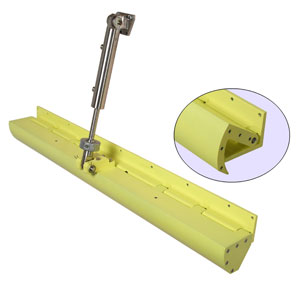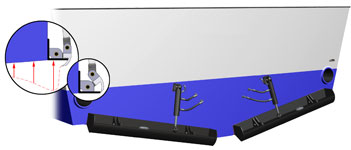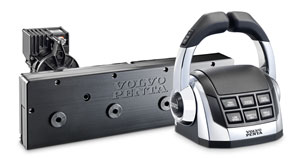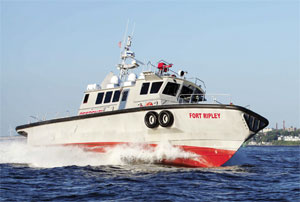Vessels ranging from the U.S. Navy’s littoral combat ships to ferries to pilot vessels to yachts are using interceptors for better performance.
Interceptors are an alternative to a trim tab on the transom, improving sea-keeping for comfort and control while boosting fuel efficiency.
A trim tab is mounted at the transom and can operate in an arc from parallel with the hull to perpendicular to the hull. It creates an area of high pressure the size of the trim tab that lifts the rear of the hull, lowering the bow angle.
An interceptor, on the other hand, extends perpendicular to the hull into the water flow under the hull. It creates a pressure center under the rear of the hull and can mitigate the forces of pitch, roll and heel of the vessel while it’s underway. In the case of the Volvo Penta system, the blades extend below the transom a maximum of 50 mm, or about two inches. The shape of the interceptor can follow almost any hull curvature.
Interceptor systems can be installed on new vessels at the shipyard, or retrofitted to existing vessels. Interceptors can be sourced from suppliers such as Naiad Dynamics or Humphree, or included as part of a propulsion package from an integrated supplier such as Volvo Penta.
 |
|
Naiad interceptors can fully retract to avoid damage from obstacles. |
|
Courtesy Naiad Dynamics |
Interceptors fine-tune the performance of a vessel for fuel savings and better handling, which can translate into improved comfort for passengers and crew. An automatic system can continuously compensate for wind and load, ensuring the vessel remains at a favorable running angle.
Interceptors help overcome the fact that “there’s no perfect boat,” said Jens Bering, manager of product management for Volvo Penta North America. “A vessel may be close to perfect in a particular speed range, and with the interceptors we can tailor the ride without any operator input. If you have a work vessel or wind-farm boat overloaded on one side, the system can compensate for the list to keep the vessel level.”
On vessels over 45 feet or so, trim tabs add drag and take longer to deploy. Interceptors can retract above the transom so they won’t be damaged by objects in the water.
“Generally, trim tabs can be used with greater effect over a wider range of hull speed, while an interceptor can be tuned to be more effective over a narrow band of hull speed, which is what more people want,” said John Venables, president and chief executive of Naiad Maritime Group Inc.
Interceptors can be fitted to just about any size of vessel. Naiad supplies systems for Navy vessels from 36-foot RIBs to one class of the 377-foot littoral combat ships. Interceptors can be part of a suite of ride control options for different speed profiles such as a T-foils and fins. A fleet of workboats in the Gulf fitted with Naida interceptors has documented a 5 percent improvement in fuel economy, Venables said.
Volvo Penta has added interceptors to several of its commercial vessel propulsion system offerings, including the IPS pod system. Volvo delivers an integrated propulsion system from helm to prop, Bering said. The interceptor system can be included in a newbuild or retrofitted to existing installations of the selected engine systems.
 |
|
Interceptors provide dynamic ride control and can cycle up and down as needed. |
|
Courtesy Naiad Dynamics |
“The beauty is, it is literally plug and play. We connect six wires into the electrical harness and mount it on the transom,” Bering said.
Volvo develops a custom profile based on the vessel’s expected use, weight, speed, payload and other factors.
“For an operator, whether it’s a commercial or leisure vessel, if you have an automatic system all you do is push the levers forward and the blades will do their thing according to the speed, which is tailored to the trim,” Bering said.
Interceptors can be fixed or adjusted manually, or be part of a dynamic ride control system linked with a GPS and a gyro for full automatic ride control. Venables said Naiad works with naval architects and builders to develop a profile and conducts sea trials to fine-tune the algorithms based on the vessel’s actual performance.
Faced with reducing wake wash as the ferry Chinook sailed through shallow waters, Washington State Ferries added a fixed interceptor to the transom. The interceptor cut the wake through sensitive waters, which increased the range of water depths the ferry could run at full speed.
With automatic interceptors, a vessel can experience full dynamic ride control as the system continuously adjusts to speed and sea conditions compensating for pitch, roll and heave to keep the vessel level.
 |
|
A Volvo Penta stabilizer system can improve handling, allowing pilot boats and other vessels to increase speed while maintaining crew comfort. |
|
Courtesy Volvo Penta |
“Once you get those things sorted out, your running attitude is right and you don’t have a list in the boat; that’s what we mean by ride control,” Venables said. “It’s full automatic real-time ride control.”
Volvo Penta has equipped several pilot boats with its IPS system and interceptors. The 65-foot Fort Ripley in Charleston, S.C., uses triple IPS pods and interceptors. Launched in October 2014, Fort Ripley serves as a firefighting and emergency response boat and a launch for the Charleston Pilots.
“The boat is easy handling so there’s less fatigue for the crew and pilots,” Bering said.
During sea trials of a new pilot boat in Tampa, the interceptors provided about 2 knots of additional speed.
“When we sea-trialed the Tampa Bay pilot boat, we found the settings for optimum fuel efficiency so we can now tailor a trim profile so that fuel efficiency is tops,” Bering said.
While assault boats for Navy SEALs might be an extreme-use case, Naiad’s interceptors helped reduce injuries to special-forces troops subjected to a pounding ride through the surf during amphibious missions.
“The Navy told us their rate of medical disabilities was higher due to the boat ride than due to fighting,” Venables said. “We were able to cut the vertical acceleration by half with the interceptors, which is a dramatic improvement for those guys.”

